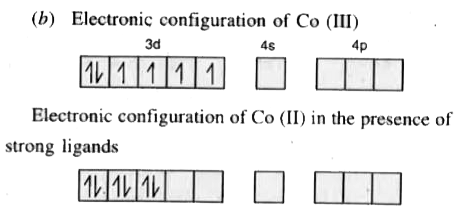How would you account for the following:
(a) of the d4 species, Cr2+ is strongly reducing while Mn3+ is strongly oxidizing,
(b) Co2+ is stable in aqueous solution but in the presence of complexing reagents it is easily oxidised.
(c) The d1 configuration is very unstable in ions.
(a) The most common oxidation state of Cr is + 3, it has a tendency to change + 2 oxidation state to +3 after removing one electron. Cr2+ is a strong reducing agent. On the other hand, d4 configuration of Mn3+ has a strong tendency to change to d5 configuration of Mn (II), which is more stable due to presence of half filled d-orbital, thus Mn(III) is a strong oxidising agent.
(b) Electronic configuration of Co (III)

Co (III) complexes are more stable than Co (II) because in Co (III) has d6 electronic configuration. In the presence of strong ligands four unpaired electrons gel paired up and thus forms diamagnetic complexes. This arrangements has very large crystal field stabilization energy. Due to this reason Co (II) changes to Co (III) in the presence of strong ligands.
(c) c) d1 configuration is very unstable in ions because after losing one more electron it will become stable,
Topper's Solved these Questions
Similar Questions
How would you account for the following :
(i) Of the d4 species, Cr2+ is strongly reducing while manganese (III) is strongly oxidising ?
(ii) Cobalt (II) is stable in aqueous solution but in the presence of complexing reagents, it is easily oxidised ?
(iii) The d1 configuration is very unstable in ions.
View SolutionHow would you account for the following:
A) Of the d4 species Cr2+ is strongly reducing while manganese(III) is strongly oxidizing.
B) Cobalt(II) is stable in aqueous solution but in the presence of complexing reagents it is easily oxidized.
C) The D1 configuration is very unstable in ions.
View SolutionHow would you account for the following :
(i) Out of the d4 species, Cr2+ is strongly reducing while manganese (III) is strongly oxidising.
(ii) Cobalt (II) is stable in aqueous solution but in the presence of complexing reagents it is easily oxidized.
(iii) The d1 configuration is very unstable in ions.
View SolutionHow would you account for the following.
(i). Of the d4 species. Cr2+ is strongly reducing while manganese (III) is strongly oxidising.
(ii). Cobalt (II) is stable in aqueous solution but in the presence of complexing reagents it is easily oxidised.
(iii). The d1 configuration is very unstable in ions.
View SolutionHow would you account for the following:
A) Of the d4 species Cr2+ is strongly reducing while manganese(III) is strongly oxidizing.
B) Cobalt(II) is stable in aqueous solution but in the presence of complexing reagents it is easily oxidized.
C) The D1 configuration is very unstable in ions.
View SolutionHow would you account for the following:
of the d4 species Cr2+ is strongly reducing while manganese(III) is strongly oxiding.
Cobalt(II) is stable in aqueous solution but in the presence of complexing reagents it is easily oxidised.
The D1 configuration is very unstable in ions.
View SolutionHow will you account for the following :
(i) Cobalt (II) is stable in aqueous solution but in the presence of a complexing agent, it is easily oxidized.
(ii) Out of d4 species, Cr2+ is strongly reducing while Mn2+ is strongly oxidising .
View SolutionHow and you account for the following :
(i) Cabalt (II) is stable in aqueous solution but in the presence of complexing reagents it is easily oxidised.
(ii) The transition elements exhibit high enthalpy of atomization.
(iii) of the d4 species, Cr2+ is strongly reducing while Mn (III) is strongly oxidsing .
View SolutionHow would you account for the following ?
(i) With the same d-orbital configuration (d4)Cr2+ is reducting agent while Mn3+ is an oxidizing agent.
(ii) The actionoids exhibits a larger numbe of oxidation states than the corresponding members in the lanthanoid series.
(iii) Most of the transition metal ions exhibit characteristic in colours in aqueous solutions.
View SolutionHow would you account for the following ?
(i) With the same d-orbital configuration (d4)Cr2+ is reducting agent while Mn3+ is an oxidizing agent.
(ii) The actionoids exhibits a larger numbe of oxidation states than the corresponding members in the lanthanoid series.
(iii) Most of the transition metal ions exhibit characteristic in colours in aqueous solutions.
View Solution
